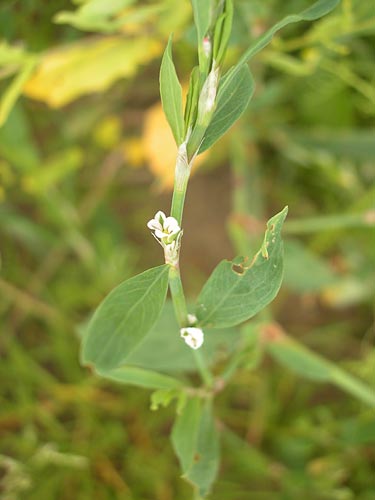Weeds
Polygonum aviculare L. - Way-Grass.
Taxonomy.
Family Polygonaceae Juss, genus Polygonum L.Synonyms.
Polygonum heterophyllum Lindm. nom. illegit., P. monspliense Thieb. ex Pers.Biological group.
This is an annual herbaceous plant.Morphology and biology.
One or several stems are prostrate to erect, 10-50 (100) cm long, un-branching at most nodes. Leaves green to grey-green, acute to obtuse. Middle stem leaves with petioles 0.5-9 mm long, very narrowly elliptic to spatulate, (6.2) 8-61 x 0.4-18 (21) mm; leaves in the upper part of the inflorescence are 2-19 (25) mm long. Ocreae brownish in the lower half. Flowers are bisexual. Perianth is 1.9-5.5 mm long. Five sub-equal sepals, having single vein are green with red margins. Three are 5 to 8 stamens. Nectaries are not visible. Three styles with very short capitate stigma. Inflorescence consists of axillary cymes, 1-5-flowered, located along the shoots or aggregated at the apices of stems and branches. Nut usually triquetrous, 2.0-3.5 x 1.5-2.0 mm, enclosed in the perianth or with the tip visible, dark brown to blackish. Flowering occurs from June to September.Distribution.
Plant grows in all major parts of the world but is probably native to temperate parts of the northern hemisphere only. Within the USSR: from the extreme North to the south of Middle Asia, the Caucasus and the Far East.Ecology.
Prefers bare, nutrient-rich mineral soils; avoids extremely dry, permanently wet, and very shady habitats. Plant grows in forest and steppe-forest zones, and especially frequently, mountains. In steppe and desert zones it occurs in wetter habitations only. In the irrigation fields it grows in the bolsters and slopes of the irrigation canals only. Indigenous habitations are seashores and perhaps also lakeshores. Road-banks, railway areas, farmyards, paths, dung heaps, fields, thin lawns and bare patches of grazed grassland.Economic significance.
Polygonum aviculare is a weed plant among the crops of field cultures, spring wheat, often winter cereals and vegetable cultures. Control measures include seed cleaning by a seed-cleaning machine and well-timed harvesting of the crop, early autumn plowing (in August) immediately after harvest, and inter-row tillage of inter-tilled crops.Reference citations:
Agaev M.G., ed. 1988. Catalogue of the world collection of VIR. N. 468. Leningrad: VIR. 11-13 p. (In Russian)Jonsell, B., ed. 2000. Flora Nordica. V. 1. Stockholm. 262-272 p. (In English)
Komarov, V.L., ed. 1936. Flora of the USSR. V. 5. Moscow-Leningrad: AN SSSR. 614-618 p. (In Russian)


